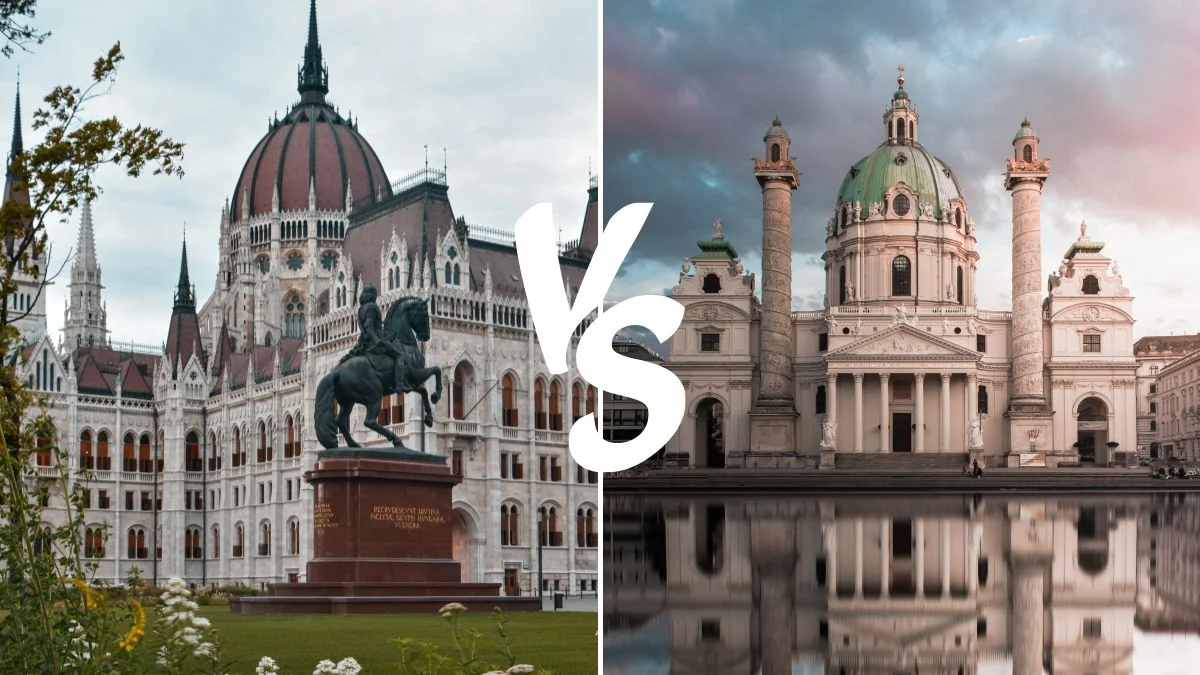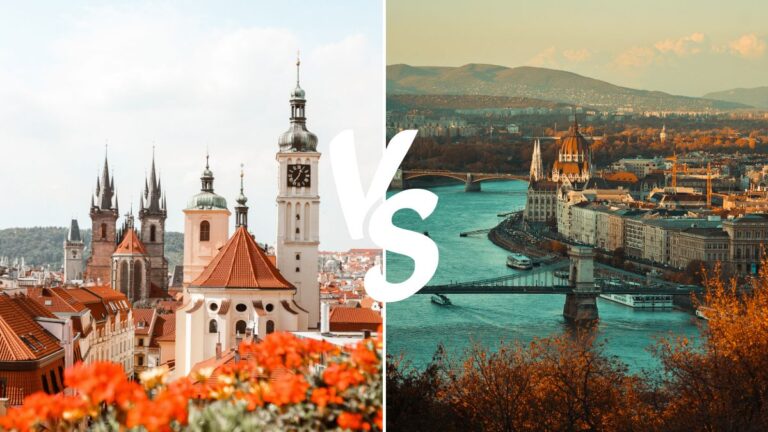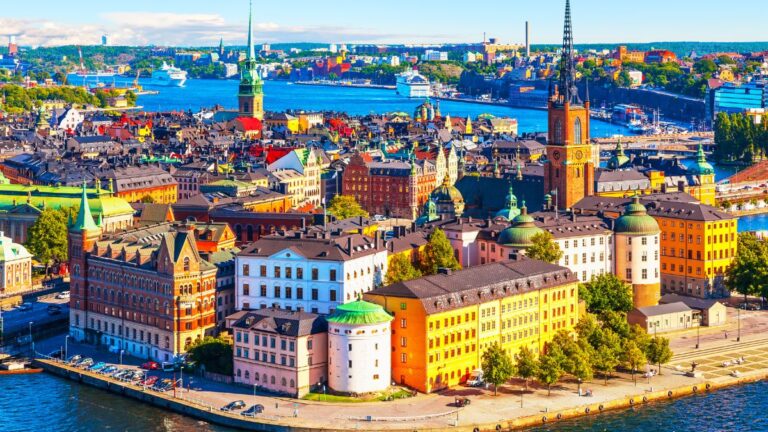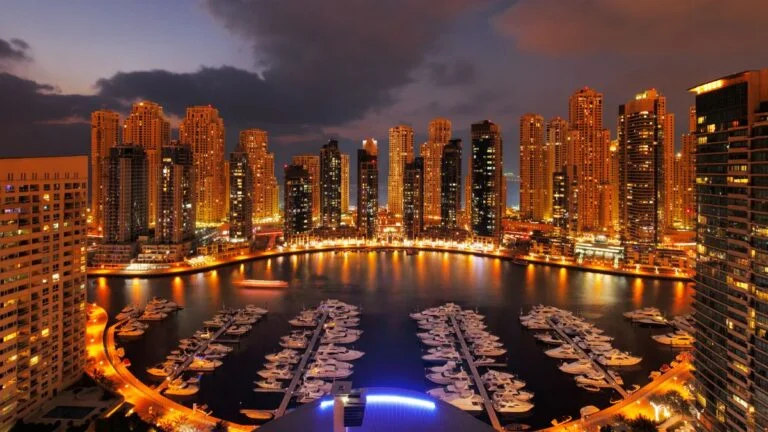Budapest Vs. Vienna: An In-depth Comparison of Two European Cultural Powerhouses

As participants in Amazon Associates and other programs, we earn from qualifying purchases. This comes at no additional cost to you. For more details, see our Affiliate Disclosure.
Nestled in the heart of Europe, Budapest and Vienna, each unique and vibrant, are cities of intrigue that bristle with history, culture, and remarkable architecture. A journey into their captivating narratives feels like stepping into pages of a beautifully illustrated storybook, where each turn leads to an unexpected discovery. Budapest, with its fascinating blend of the east and west, tugs at the heartstrings, while Vienna, the elegant and timeless beacon of music and art, sweeps you off your feet.
This article presents an in-depth comparison of these two European cultural powerhouses, offering an enlightening perspective for travel enthusiasts, history buffs, and culture vultures alike.
Historical Overview: Budapest and Vienna through the Ages
As the capitals of Hungary and Austria respectively, Budapest and Vienna boast rich histories that have left indelible marks on their present cultures, landscapes, and identities. These cities’ stories are told not only through their grand architecture and museums, but also through the echoes of their past in the daily lives of their inhabitants.
Budapest: The Heart of Hungary
Budapest, straddling the mighty Danube River, was historically two separate cities: Buda, with its ancient, hilltop castle and charming, narrow streets, and Pest, known for its grandiose Parliament and bustling city life. They unified in 1873 to form the city we know today.
Budapest has survived numerous invasions, occupations, and even revolutions over the centuries. Its story is one of resilience, visible in its eclectic mix of architectural styles, each marking a different era in the city’s history. From the Roman ruins of Aquincum to the Neo-Gothic splendor of the Parliament building, Budapest’s past comes alive in its cityscape.
Vienna: Austria’s Imperial Gem
Vienna’s history, in contrast, is one of imperial grandeur. As the historical capital of the Habsburg Monarchy and later the Austro-Hungarian Empire, the city exudes a certain opulence and majesty. It’s here where emperors commissioned spectacular palaces, like the Hofburg and Schönbrunn, and famous composers like Mozart, Beethoven, and Schubert created some of their most celebrated works.
The city’s legacy as a hub for classical music and the arts is a testament to its imperial past. But Vienna’s history is not without darkness; the scars of the World Wars, and the subsequent occupation by the Allies, have also shaped its modern identity.
The histories of Budapest and Vienna have followed different paths, marked by periods of glory and hardship, resilience and reinvention. They continue to evolve, adding new layers to their historical tapestry, making them fascinating to explore and compare.
Architectural Styles: Contrasting Beauty
Architecture is one of the most visible and enduring expressions of a city’s history and culture. Budapest and Vienna, steeped in rich histories, showcase a diverse array of architectural styles that narrate their unique and shared pasts.
Budapest: Eclectic Elegance
Budapest’s architecture is a visual feast. The city presents an eclectic mix of architectural styles, reflecting the various periods it has lived through. Roman ruins in the Aquincum Museum bear testament to ancient times, while the Gothic Revival style of the Hungarian Parliament Building narrates tales of a growing 19th-century metropolis.
The cityscape is dotted with Art Nouveau masterpieces, like the Gresham Palace, now a luxurious hotel, and the Széchenyi Baths, Europe’s largest medicinal bath, embodying the style’s characteristic decorative elegance.
The grand boulevards and squares of Pest are reminiscent of Paris, while the hilly, historic district of Buda, with the Castle and Fisherman’s Bastion, echoes of a medieval past. Meanwhile, “Panelák” buildings, remnants of the Soviet-era, stand as sobering reminders of a more recent history.
Vienna: Imperial Splendour and Modernism
Vienna, on the other hand, is known for its grand imperial architecture and a unique commitment to modernism. The opulent palaces like the Hofburg and Schönbrunn, as well as grand buildings along the Ringstraße, like the Vienna State Opera and the Parliament, tell tales of the city’s Habsburg past.
They represent the pinnacle of Baroque, Neo-Renaissance, and Neo-Gothic architecture. Yet, Vienna was also a major center for the Secession movement in the late 19th and early 20th centuries. Buildings like the Secession Building, with its stunning Beethoven Frieze, and the famously unconventional Hundertwasserhaus are testament to the city’s embrace of modernist and contemporary architecture.
Vienna has masterfully preserved its historic architecture while also fostering a culture of architectural innovation, leading to a fascinating juxtaposition of old and new.
Whether it’s Budapest’s picturesque blend of architectural styles, reflecting the city’s layered history, or Vienna’s exquisite Imperial buildings and innovative modernist structures, both cities are architectural treasures that beg to be explored and appreciated.
Culinary Landscape: A Tale of Two Cities
Cuisine is a vibrant expression of a region’s culture, often telling tales of its history, geography, and traditions. The culinary landscapes of Budapest and Vienna offer delectable insights into the rich cultural fabrics of these two cities, each with its unique flavors and dining traditions.
Budapest: Comforting and Spicy
Hungarian cuisine, showcased brilliantly in Budapest, is characterized by its robust flavors, generous use of spices, particularly paprika, and hearty dishes. It is a cuisine forged by the pastoral traditions of the Hungarian plains and the influences of the many cultures that have traversed this land.
Goulash, a hearty soup-stew hybrid of meat and vegetables, is a beloved national dish. Budapest’s street food scene is worth exploring, with treats like “Lángos”, a deep-fried dough topped with sour cream and cheese, offering a taste of the local palate.
The city’s growing fine dining scene, with several Michelin-starred restaurants, is innovatively reinventing traditional Hungarian dishes, offering an intriguing blend of the old and new.
Vienna: Elegant and Decadent
In contrast, Viennese cuisine is rooted in the city’s imperial past, with a dash of influences from the Austro-Hungarian Empire. Viennese coffee house culture, recognized by UNESCO as Intangible Cultural Heritage, is central to the city’s culinary identity.
The grand coffee houses serve not only a variety of coffee but also a wide array of pastries, like the world-renowned “Sachertorte”, a decadent chocolate cake. Savory fare such as Wiener Schnitzel, a breaded and fried veal cutlet, and Tafelspitz, boiled beef in broth, showcase the city’s traditional culinary prowess.
Vienna’s food scene also reflects its status as a cosmopolitan city, with a range of international cuisines readily available.
While Budapest offers a hearty and comforting culinary journey, Vienna charms with its refined and elegant gastronomy. Both cities, however, provide memorable culinary experiences that are deeply intertwined with their respective histories and cultural identities.
Art and Music: Melodies and Masterpieces
Budapest and Vienna are renowned for their contributions to the arts, each providing a distinct blend of history, culture, and creativity. Their artistic and musical landscapes offer a captivating journey through a rich tapestry of creativity and tradition.
Budapest: Diverse Artistic Heritage
Budapest’s artistic landscape is as diverse as its history. Hungarian art, often influenced by its Eastern roots and Western connections, reflects the nation’s unique position in Europe. From the Hungarian National Gallery, showcasing centuries of local art, to the Ludwig Museum, housing contemporary pieces, Budapest’s art scene is a thrilling blend of the traditional and the modern.
Music, especially folk and classical, has a special place in Budapest. The city is home to the Franz Liszt Academy of Music, one of Europe’s premier music institutions. Furthermore, the grand Budapest Opera House is a hub for classical performances, while outdoor festivals like Sziget bring global pop and indie artists to the city. Budapest is also the birthplace of “Gypsy” music, a genre that deeply influences Hungarian music and dance.
Vienna: Capital of Classical Music
In Vienna, art and music are inseparable from the city’s identity. For centuries, Vienna has been a crucible for some of the greatest names in art and particularly music. The city was home to classical maestros like Mozart, Beethoven, and Schubert, earning it the title ‘Capital of Classical Music’. The Vienna Philharmonic and the Vienna State Opera continue this proud tradition with their world-class performances.
Viennese art, like its music, is steeped in tradition yet open to innovation. From the masterpieces of Gustav Klimt and Egon Schiele displayed at the Belvedere and Leopold Museums, to the edgy contemporary exhibitions at the Museum of Modern Art (MUMOK), Vienna’s art scene strikes a delicate balance between preserving the old and embracing the new.
Whether it’s the diverse artistic heritage of Budapest, reflected in its diverse music and art scenes, or Vienna’s status as a classical music capital and a nexus of artistic tradition and innovation, both cities offer profound and enriching cultural experiences.
Outdoor Spaces: Parks and Greenery in Budapest vs. Vienna
Outdoor spaces serve as the lungs of a city, providing both residents and visitors with a place to unwind, socialize, and connect with nature. Both Budapest and Vienna offer an array of green spaces, each with unique features that mirror the city’s cultural and historical narrative.
Budapest: Riverside Charm and Thermal Baths
Budapest’s outdoor spaces are as distinctive as the city itself. The River Danube, splitting the city into Buda and Pest, offers numerous picturesque spots and panoramic vistas. The banks of the river are perfect for leisurely walks, with landmarks like the Parliament building and the Buda Castle enhancing the scenery.
The city’s hills, especially Gellért Hill and the Buda hills, provide hiking trails and breathtaking views over Budapest. The City Park, home to the Széchenyi Thermal Baths, the Budapest Zoo, and Vajdahunyad Castle, is another oasis of greenery.
However, it’s the city’s thermal baths, such as Széchenyi and Gellért, that are truly unique, providing outdoor and indoor relaxation amidst warm, mineral-rich waters, making them must-visit sites, regardless of the season.
Vienna: Imperial Gardens and Woods
Vienna’s outdoor spaces reflect its imperial past and deep love for nature. The meticulously maintained gardens of Schönbrunn Palace and Belvedere Palace, with their baroque landscapes, fountains, and sculptures, are a window into the city’s royal history.
The Prater, a large public park, offers not only wide-open green spaces but also the iconic Riesenrad Ferris wheel and a comprehensive amusement park. Yet, the jewel in Vienna’s crown is the Wienerwald, or Vienna Woods. This UNESCO Biosphere Reserve on the city’s outskirts offers extensive hiking trails, vineyards, and panoramic views over Vienna.
Another unique feature is the Danube Island – a long, narrow island in central Vienna offering a variety of outdoor activities from swimming and boating in the summer to cozy beach bars and restaurants.
Both Budapest and Vienna value their green spaces, providing residents and visitors alike with a variety of options for leisure, relaxation, and recreation. The outdoor spaces in both cities are reflections of their distinct histories, contributing significantly to their unique charms.
Nightlife: From Elegant Balls to Spirited Ruin Bars
Nightlife, as much as the daylight hours, is reflective of a city’s spirit and cultural depth. Budapest and Vienna, each with their distinctive vibes and traditions, offer vibrant nocturnal experiences that cater to diverse tastes.
Budapest: From Ruin Bars to Riverside Raves
Budapest’s nightlife is electric, eclectic, and full of surprises. The city is globally renowned for its ruin bars, unique venues that have sprung up in abandoned buildings and courtyards in the city’s District VII. Szimpla Kert, the original ruin bar, is a labyrinth of eclectic decor and pulsing energy, and is a must-visit. A multitude of clubs and bars spread throughout the city cater to all music tastes, from electronic and pop to rock and jazz.
Summer nights in Budapest often gravitate to the Danube River, where party boats and open-air clubs provide stunning views to accompany the beats. Festivals such as Sziget and Balaton Sound also contribute to the city’s reputation as a go-to destination for music lovers.
Vienna: Classical Concerts and Elegant Balls
Vienna’s nightlife, while diverse, carries a sense of the city’s elegant charm and historical grandeur. The city is world-renowned for its classical concerts, many taking place in beautiful historic venues such as the Vienna State Opera, the Musikverein, and the Konzerthaus. Experiencing a performance in any of these venues is akin to traveling back in time to the city’s imperial days.
An enduring tradition of Vienna’s nightlife is its annual ball season, where over 450 balls take place, including the celebrated Vienna Opera Ball. These events are characterized by live orchestral music, formal attire, and traditional dances like the waltz.
But Vienna also offers modern entertainment, with a range of bars and clubs, particularly in the districts around the Danube Canal and in the Prater area. The city’s burgeoning craft beer scene is worth exploring, and summer beach bars along the Danube River add a lively note to Vienna’s refined nocturnal landscape.
Whether it’s Budapest’s energetic ruin bars and music festivals or Vienna’s classical concerts and grand balls, both cities offer unforgettable night-time experiences, brimming with cultural flavor and local charm.
Public Transportation: Ease and Efficiency Compared
Effective public transportation plays a critical role in urban life, offering both locals and tourists easy and efficient ways to explore and navigate cities. Both Budapest and Vienna have well-developed public transport networks, each with its unique characteristics and advantages.
Budapest: On Trams and Thermal Baths
Budapest’s public transportation system, consisting of trams, buses, trolleys, and a four-line metro system, is extensive and reliable. The city’s tram network is particularly impressive, with Tram #2 being notable for its scenic route along the Danube River, offering passengers panoramic views of iconic landmarks.
One of the unique features of Budapest’s public transport is the Cog-wheel railway and the Children’s railway, both offering not only transport but also a unique experience, especially for families.
But perhaps the most unusual aspect of Budapest’s public transport is the funicular railway leading up to Buda Castle, and the boats on the Danube, making the city’s stunning geographical features an integral part of the transit experience. The historic Metro Line 1 (yellow line), a UNESCO World Heritage site, further adds to the city’s unique transport landscape.
Vienna: Riding the U-Bahn and Historic Trams
Vienna’s public transportation network is renowned for its efficiency, punctuality, and extensive coverage. It includes trams, buses, and a five-line underground system known as the U-Bahn, which is the quickest way to get around the city.
Trams in Vienna, much like in Budapest, offer an excellent way to see the city. The historic Ring Tram takes passengers around Vienna’s famous Ringstraße, offering views of significant landmarks and architectural gems.
A unique feature of Vienna’s transport system is the S-Bahn, a suburban train network that easily connects the city with its surrounding regions, including the Vienna Woods and numerous vineyards.
Vienna also boasts an extensive network of cycle paths, and CityBike Wien, a bike-sharing service, is a popular alternative for getting around the city, especially in warmer months.
While both Budapest and Vienna have highly effective public transport systems, each offers its unique experiences, be it a scenic tram ride by the Danube or a trip around Vienna’s historic Ringstraße. Both systems allow locals and visitors alike to navigate these European cultural powerhouses with ease and convenience.
Cultural Festivals: Celebrations That Define Each City
Cultural festivals are vibrant expressions of a city’s heritage and traditions. They offer residents and visitors alike an opportunity to immerse themselves in the local culture. Both Budapest and Vienna host a multitude of festivals throughout the year, reflecting the cities’ rich histories and dynamic contemporary cultures.
Budapest: Music, Wine, and Tradition
Budapest’s festival calendar is characterized by its diversity and enthusiasm. The Sziget Festival, one of Europe’s largest music and cultural festivals, is the city’s highlight, attracting music lovers from all over the world for a week of concerts and performances on an island in the Danube.
Wine and gastronomy festivals, like the Budapest Wine Festival and the Goulash Festival, celebrate Hungary’s culinary heritage. These events offer visitors a chance to sample a wide array of Hungarian wines and traditional dishes, often accompanied by folk music and dance performances.
The Spring and Autumn Festivals showcase a broad spectrum of arts, from music and dance to visual arts and film, while traditional events like the National Gallop and the Busójárás Carnival in nearby Mohács offer a glimpse into Hungary’s rich folk traditions.
Vienna: Balls, Art, and Christmas Markets
Vienna’s festival scene mirrors the city’s blend of tradition and modernity. The Vienna Ball Season, with over 450 balls, ranging from the lavish Vienna Opera Ball to specialized balls like the Coffeehouse Owners’ Ball, is a unique tradition, turning the city into a dance floor every winter.
The Vienna Festival in spring offers a blend of contemporary and classical music, theater, and visual art performances at various venues across the city. For film enthusiasts, the Viennale, Vienna’s international film festival, is a highlight of the cultural calendar.
One of Vienna’s most cherished traditions is its magical Christmas markets, with the Viennese Dream Christmas Market in front of the City Hall and the Christmas Village at Belvedere Palace being particularly enchanting. These markets fill the city with festive cheer, offering everything from handmade crafts and decorations to warming mulled wine and traditional Austrian Christmas treats.
Whether it’s the dynamic music and culinary festivals of Budapest or the elegant balls and artistic celebrations of Vienna, both cities offer a rich and varied roster of events that reflect their distinctive cultural identities and provide unique experiences for residents and visitors alike.
Cost of Living and Tourism: A Comparative Analysis
Cost of living and tourism costs are important considerations for both residents and visitors. While both Budapest and Vienna offer a high quality of life and numerous tourist attractions, they vary in terms of cost, providing different experiences for different budgets.
Budapest: Affordable Living and Exploring
Budapest, often considered one of the most affordable capital cities in Europe, offers a cost-effective living and tourism experience without compromising on cultural richness or lifestyle quality. Accommodation, food, and transport are generally less expensive compared to Western European cities.
While tourist attractions like the Hungarian National Museum, the Széchenyi Thermal Bath, and the Fisherman’s Bastion have entry fees, they are reasonably priced. There are also numerous free activities, like walking across the iconic Chain Bridge, exploring the historic district of Castle Hill, or taking in the views from Gellért Hill.
Vienna: Quality and Refinement at a Price
Vienna, while more expensive than Budapest, offers a high standard of living, reflected in its frequent ranking among the top cities for quality of life. Its efficient public transport, well-maintained public spaces, and world-class public services make it a comfortable city to live in, albeit at a higher cost.
As a tourist destination, Vienna offers an array of attractions, from historical sites like Schönbrunn Palace and St. Stephen’s Cathedral to cultural experiences like the Vienna State Opera and the Museum Quarter. While entry fees can add up, there are numerous ways to explore Vienna on a budget, including enjoying its coffee culture, exploring its parks, or strolling around its historic districts.
Here’s a comparative table illustrating the basic costs in both cities as of 2023:
| Expense | Budapest | Vienna |
|---|---|---|
| Meal at an Inexpensive Restaurant | $10 | $12 |
| Domestic Beer (0.5 liter draught) | $2 | $4 |
| Cappuccino (regular) | $2 | $3.5 |
| Monthly Public Transport Ticket | $33 | $53 |
| Basic Utilities (Monthly for a 85m2 Apartment) | $150 | $200 |
| Rent (1 bedroom apartment in city centre) | $500 | $900 |
| Entry to Main City Attraction | $15 | $20 |
(Note: These are average prices and actual costs may vary)
Whether it’s the affordability of Budapest or the high living standards of Vienna, both cities cater to different lifestyle and budget preferences, while continuing to offer vibrant cultural experiences and a rich quality of life.
Budapest Vs. Vienna: Which One To Visit First?
Deciding between Budapest and Vienna for your first visit can be a delightful dilemma, as both cities are renowned for their historical grandeur, cultural richness, and undeniable charm. The choice, in the end, might depend on your personal preferences, interests, and travel objectives.
Budapest: A Blend of Historic and Hip
If your interests lean towards exploring eclectic architecture, immersing yourself in a vibrant nightlife, or unwinding in thermal baths, Budapest could be your ideal starting point. The city offers a fascinating mix of historical landmarks and trendy spots, from the Gothic Revival style Parliament building and the medieval Buda Castle to the edgy ruin bars and contemporary art scene.
Budget-conscious travelers might also find Budapest more affordable, both in terms of cost of living and tourist attractions. Hungary’s capital is often praised as one of the best value destinations in Europe, offering a rich travel experience without breaking the bank.
Vienna: Imperial Elegance Meets Modern Sophistication
On the other hand, if your passion lies in classical music, imperial history, or contemporary art, you may want to begin your journey in Vienna. The city is famous for its elegant architecture, historic palaces, and world-class museums. It’s also a mecca for classical music lovers, being home to iconic institutions like the Vienna State Opera and the Vienna Philharmonic.
Vienna also impresses with its high quality of life, efficient public transport, and beautifully maintained parks and public spaces. Although it can be more expensive than Budapest, the city offers a refined cultural and lifestyle experience that many travelers find worth the expense.
Ultimately, whether you choose the historic yet hip allure of Budapest or the elegant sophistication of Vienna, both cities promise unforgettable experiences steeped in European history and culture. And given their proximity – just a two-and-a-half-hour train ride apart – you might consider making time to explore both on your next European adventure.






